

The government of Brazil has declared that the fight against hunger is its highest priority. President Luiz Inácio Lula da Silva’s government took office in January with a pledge to eradicate hunger by the end of his four-year term.
Brazil is a major exporter of crops and meat, but over 40 million of its 170 million people live on less than US$1 per day. Hunger is greatest in rural areas of northeastern Brazil, but its incidence is rising rapidly in the cities.
To reduce hunger quickly and permanently, the government has adopted a two-pronged strategy. Projeto Fome Zero (Zero Hunger Project) combines emergency interventions to put food on the plates of the hungry with initiatives to increase employability, reduce poverty and stimulate food production.
To provide immediate relief to the most needy families, Fome Zero issues electronic cash cards to meet food purchase needs. Hungry Brazilians will also benefit from programmes to provide free or low-cost meals through schools, workplaces and “people’s restaurants”. To avoid fostering dependency, eligibility for food assistance is tied to participation in literacy and skills training.
The long-term strategy of Fome Zero is to attack the root causes of hunger: poverty, unemployment and landlessness. The project includes measures to increase the minimum wage, speed up agrarian reform and provide a minimum income to needy households with school-aged children.
Fome Zero aims to reduce rural poverty and hunger by using the increased demand created by food safety nets to stimulate expanded production by small and medium-sized farms. The project includes initiatives to improve access to credit, insurance and extension services for family farmers.
Fome Zero has got off to a fast start. By the end of May, tens of thousands of families in 181 drought-affected municipalities were receiving monthly allocations to buy food. More than 10 000 water tanks had been built to minimize the impact of drought.
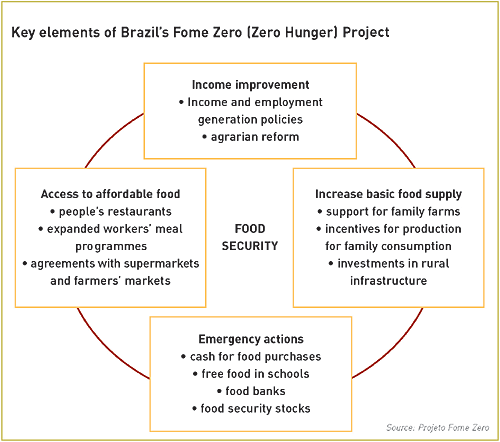
Fome Zero is overseen by a National Food Security Council, which brings together representatives from government and civil society organizations. The Project enjoys immense public support, with much of the momentum coming from non-governmental organizations, the private sector and individuals who want to help rid Brazil of hunger.
A hunger eradication programme launched at the provincial level in 1992 and extended nationwide in 1996 has helped Viet Nam make rapid progress towards its declared goal of ensuring household food security.
Spurred by rapid economic growth and investments in agriculture and rural development, Viet Nam succeeded in sharply reducing the proportion of the population who were undernourished during the 1990s (see graph). The interdisciplinary Hunger Eradication and Poverty Reduction Programme played a major part in achieving this progress and ensuring that poor and isolated communities are not left behind.
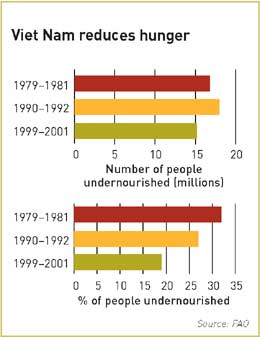
Overall, hunger and poverty have decreased dramatically in rural areas, while agricultural production has soared. But poverty rates remain almost twice as high in the countryside (11.2 percent) as in cities (6 percent). In some mountainous areas and communities of ethnic minorities, more than half the population still live in poverty.
The Hunger Eradication Programme targets the poorest communes for a range of services, including access to credit, extension and training, employment and nutrition education. In addition, it has invested an average of US$60 000 a year in each of more than 2 000 communes, hiring local people to improve roads, bridges, irrigation facilities, schools and other infrastructure. The Programme aims to eliminate chronic hunger by 2005 and reduce poverty to below 5 percent by 2010.
In 1992, Tunisian President Zine El Abidine Ben Ali visited remote areas of the country and saw first-hand that poor communities lacked roads, electricity, water and other basic infrastructure. Within less than a year, Tunisia enacted laws to establish a National Solidarity Fund (NSF). A decade later, the fund has distributed almost US$450 million to 1 327 poor and isolated communities and has become a model for international efforts to eradicate poverty.
The NSF gathers funds from many sources, including individuals, businesses, the government and national and international organizations. These funds are used exclusively for projects in areas that lack resources to ensure even the minimum conditions for a decent life. Residents of the communities help set priorities, plan projects and select beneficiaries.

Through its first eight years, the fund helped bring electricity to 72 000 households, supplied drinking water for 81 000 households and helped build more than 30 000 homes and 122 health care centres. Solidarity Fund projects also helped launch nearly 60 000 small income-generating projects and created over 17 000 jobs.
Inspired by the success of Tunisia’s NSF, the World Summit on Sustainable Development in Johannesburg unanimously endorsed the creation of a global fund to reinforce the fight against poverty. In December 2002, the United Nations General Assembly adopted a resolution calling for effective and immediate implementation of the World Solidarity Fund. The Fund accepts voluntary contributions from public and private organizations and individuals and is managed by the United Nations Development Programme (UNDP).
An Intergovernmental Working Group (IGWG), established by the FAO Council and charged with developing voluntary guidelines for the progressive realization of the right to adequate food, held its first session in March 2003. FAO provides the secretariat for the IGWG, working closely with the United Nations High Commission for Human Rights. Representatives of 87 countries participated in the session. Most members confirmed their country’s interest in having guidelines that would serve as a practical tool for implementing the right to food. Representatives of civil society and international organizations also stressed the urgent need for such guidelines.
A first draft of the Voluntary Guidelines has been prepared by the seven-member IGWG Bureau for submission to the Second Session of the Working Group in September 2003. The IGWG has been mandated to complete the task of elaborating guidelines before the October 2004 meeting of the Committee on Food Security (CFS).
IN RURAL AREAS across the developing world, water is often the key ingredient for efforts to reduce hunger. Projects and research in a number of countries have highlighted the impact reliable access to water can have on improving food production, rural incomes and nutritional status.
Where it is possible, irrigation is the best option for increasing agricultural production (see page 12). In Africa, where only 4 percent of cropland is irrigated, small-scale irrigation and rainwater harvesting projects have shown great potential for increasing yields and reducing vulnerability to erratic rainfall (see graph).
Crop production is by no means the only source of food and income that depends on water. Many poor households engage in home-based industries for which water is essential. And growing numbers of farmers, particularly in Asia, are finding that they can both increase rice yields and add a valuable source of protein and income by using the water in their rice paddies to raise fish.
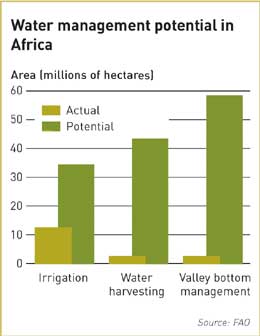
A recent FAO study of three projects in Africa found that introducing small-scale irrigation not only improved crop yields but also led directly to gains in nutrition and health.
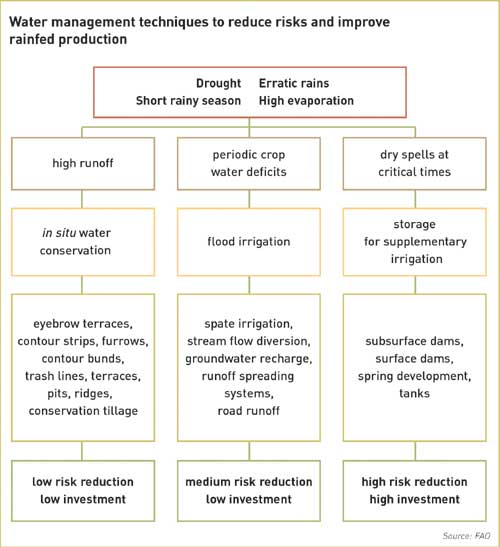
In Mali, farmers used water from a small dam both to increase food production and to introduce new crops, including vegetables that are rich in micronutrients. In Burkina Faso, families invested some of their increased farm income in health care. Visits to local clinics shot up by 50 percent. And in Tanzania, women who no longer had to spend hours fetching water used the time to start market gardens, improving both their incomes and their diets.
In all three countries, irrigation increased food production and incomes by enough to provide one additional meal each day, even during the “hungry season” before the harvest, when many families previously ate only once a day.
Farmers can also use a variety of simple, affordable water management techniques to increase yields and reduce vulnerability to drought (see chart). Rainwater harvesting involves collecting whatever rain does fall and delivering it when and where it is needed most. Techniques include capturing water from a wider catchment area and directing it into the field in which crops are grown. Studies in several African countries have shown that rain harvested from one area can triple or quadruple production on another area of comparable size.
Alternative forms of tillage – such as turning the soil only along plant lines or deep ploughing to break up soil crusts – can also lead to much more efficient use of limited rainfall. Studies have shown that rainwater harvesting and alternative tillage can increase yields two to three times as compared with conventional dryland farming (see graph). And rainwater harvesting provides other benefits as well. In addition to providing more water for crops, it also helps recharge groundwater and reduce soil erosion.
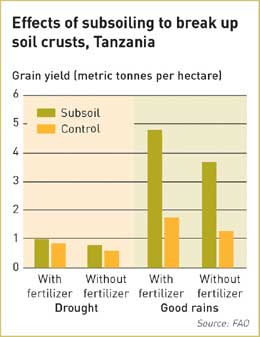
Recent studies have highlighted the importance of water to many other activities that are vital to the livelihoods of vulnerable households in rural areas.
In the Bushbuckridge area in South Africa, for example, researchers found that many households relied on domestic water supplies for a wide variety of small-scale industrial and agricultural activities, including brewing, building, tending goats and cattle, and cultivating home gardens and orchards (see graph). Surveys confirmed that these activities tend to be particularly important for the poorest and most vulnerable members of the community, including many female-headed households.
As countries institute reforms intended to allocate water to different stakeholders based on assessment of their minimum needs, it is essential to increase awareness of the key role that domestic water plays in the livelihoods of poor rural households.

Raising fish in rice fields can increase rice yields while providing a valuable source of protein and extra income. Farmers in many Asian countries have shown that a 1-hectare rice field can yield 50 to 300 kg of fish each year. Farm families usually consume most of the fish from their fields but can sell surplus to supplement their incomes.
Fish have also been found to increase rice yields by as much as 15 percent. Fish eat weeds and pests, such as insects and snails, and recycle nutrients by depositing faeces in the soil. By devouring pests, fish contribute to integrated pest management (IPM) practices that minimize the economic and environmental costs of pesticides. Studies in Indonesia have shown that use of IPM can reduce the average number of times pesticides are applied to rice fields from 4.5 to 0.5 per year, substantially cutting both costs and levels of toxic chemicals that can make fish farming impossible.
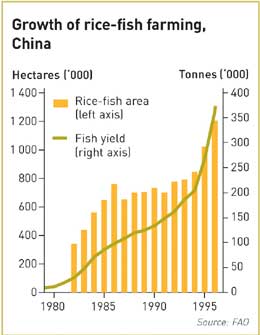
TO COMBAT HUNGER and poverty effectively, it is important to know where hungry and impoverished people are concentrated. National estimates of the number of undernourished people or the proportion of the population living on less than US$1 per day provide useful indications of national progress over time. But they cannot be used to target specific villages and the conditions that inflict poverty and hunger on their inhabitants.
Taking advantage of recently developed techniques that generate estimates of local poverty, a number of countries have used geographic information system (GIS) technology to construct detailed poverty maps. These maps can be combined with other geo-referenced data to highlight areas where hunger and poverty overlap with other social, economic and environmental problems. Maps can be made, for example, to show semi-arid agricultural areas with poor access to roads and high levels of goitre and female illiteracy. This information can then be used to design programmes that address specific local problems.
Malawi poverty maps help target public works projects With support from the International Food Policy Research Institute (IFPRI), Malawi has produced an Atlas of social statistics. Poverty maps included in the atlas have been used by the World Food Programme and the Malawi Social Action Fund to target public works projects that provide employment and improve infrastructure in impoverished communities. Maps in the atlas are also expected to be used to assist distribution of free fertilizers and seeds in Malawi’s “starter pack” programme. Combining poverty maps with maps of other socio-economic and environmental indicators may reveal factors that contribute to hunger and suggest avenues for action. Many areas in southern and central Malawi exhibit both high rates of poverty and low maize yields.
|
Poverty maps are often constructed using a technique known as “small area estimation”. This approach combines census data with information obtained from surveys such as the Living Standards Measurement Survey.
Taken separately, each data set offers distinct advantages and limitations. Data from population and agricultural censuses cover every household, allowing precise mapping at local levels. But censuses are conducted infrequently and rarely include the full set of indicators policy makers need. Household surveys, on the other hand, are carried out more frequently and often gather all the relevant indicators, such as household income and consumption expenditures. But they are based on small samples that are adequate to construct statistically valid national profiles but not for mapping at the village level.
The small area estimation method projects patterns visible in survey data onto demographically and socially similar groups of households that can be identified in the more comprehensive census data. These projections can then be used to “predict” average poverty levels for a village or group of villages with as few as 500 households.
A growing number of countries are using poverty maps to target food aid and public works projects to areas where the poorest people live (see boxes). Because this poverty mapping approach depends on census and survey data, the maps may not reflect seasonal food shortages and hardships. But they provide a valuable baseline for planning and monitoring. Experience in several countries suggests that the maps also contribute to increased awareness and participation because people find them easy to understand.
Application of the small area estimation technique for poverty mapping in developing countries is relatively
new. Much of the basic work has been done by a team in the World Bank Research Department. Other pilot applications have been funded by the International Food Policy Research Institute, the Rockefeller Foundation, the British Department for International Development, Norwegian Aid and the FIVIMS Secretariat.
More recently, the Consultative Group on International Agricultural Research, UNEP/GRID-Arendal and FAO have launched a project to incorporate spatial analysis tools into poverty mapping. These tools will help analyse the linkages between poverty and the environment. Depicting how concentrations of poverty overlap different agroecological zones, major foodcrop production systems or fragile areas vulnerable to degradation can help shape effective, sustainable action to combat hunger
Maps help Panama deliver school lunches to poorest children Panama has applied poverty mapping to help target US$150 million in expenditures by its Social Investment Fund (SIF). A school lunch programme funded by SIF used the maps to reach 120 000 extremely poor children in 1 500 schools. A division of the Health Ministry is combining poverty maps with community surveys to monitor and assess nutrition programmes.
"Food for work" reaches Cambodia's poorest comunes Cambodia has launched major poverty and food insecurity mapping initiatives. The World Food Programme used a commune-level poverty map to help allocate US$50 million in food aid. “Food for work” jobs building roads, schools and health centres and rehabilitating irrigation facilities were targeted to the poorest communes. An interministerial FIVIMS committee is coordinating efforts to produce more detailed food insecurity maps, with participation and support from a FIVIMS network that includes major donor agencies and United Nations and non-governmental organizations. These maps will be used to plan and target a wide range of programmes to reduce hunger and poverty.
|
IN RECENT YEARS, many countries have implemented community-based food and nutrition programmes. The scope and objectives of these programmes vary, ranging from broadly defined efforts to improve household food security to narrowly targeted campaigns to reduce deficiencies of a single micronutrient.
An effective nutrition programme necessarily means improved nutritional status that can be measured, for example, in lower rates of underweight children or micronutrient deficiencies. But to qualify as a success, it must also be able to sustain and extend these achievements over time.
In order to shape initiatives that will have significant and lasting impact, it is essential to understand the factors that allow some programmes to succeed where others fail. FAO recently conducted an in-depth analysis of selected programmes that have functioned for at least five years and achieved significant improvement in nutritional status. The results of that analysis highlighted a number of common factors that distinguish these successful and sustainable programmes. These factors include: strong political support, effective multisectoral collaboration, community participation and empowerment, and use of existing community structures and cultural traditions.
Over the past 20 years, Viet Nam has achieved remarkable success in reducing hunger. Between 1979–1981 and 1999–2001, the proportion of undernourished people in Viet Nam fell from 32 to 19 percent. A community nutrition project that combines home gardening with nutrition education for families with malnourished children has made a significant contribution to that success.
The project started in 1991 with a relatively narrow focus – to reduce vitamin A deficiency among children in four communes. To accomplish that, it provided training, technology and very small grants to help families establish home gardens where they could grow nutrient-rich fruits and vegetables. At the same time, parents were taught about the importance of the “coloured bowl”, a concept used in Viet Nam to illustrate a balanced meal. The white rice or rice soup can be coloured brown by adding meat or fish, green by adding vegetables and yellow by adding eggs.
A follow-up survey conducted three years after the project was launched showed that participating communes were growing and eating more than twice as many vegetables and fruits and more than 20 times as much fish as they had previously (see graph). Daily vitamin A intake among participating children was twice that of children in a control commune. The broader nutritional impact could be measured with a ruler. The proportion of children who were stunted had been reduced by almost 20 percent.
Based on this success, a far larger project combining home gardening and nutrition education was extended to eight provinces, beginning in 1997. An evaluation after two years found that malnutrition had been reduced by 12.8 percent in participating communities.
In Panama, a project that began by teaching schoolchildren in 13 poor communities how to plant, grow and eat nutritious foods has taken root.
The project aimed to improve children’s food security and nutritional status by providing the tools and training to cultivate school gardens, including vitamin-rich vegetables and poultry. And it achieved impressive results. A follow-up survey conducted three years after the project was launched found that the proportion of children who were underweight had been reduced by almost half, from 19.9 to 10.6 percent. Indigenous communities participating in the project showed even more dramatic improvement, with undernutrition falling by 85 percent in one case (see graph).
The training and the impact reached far beyond the students themselves to include their parents, teachers, local farm leaders and technical experts from both government ministries and non-governmental organizations. And it benefited from a multidisciplinary approach that relied on local resources and low-cost, environmentally friendly technologies. Along with seeds, tools and lessons in growing crops, the project emphasized community participation, small animal keeping, nutrition education, food processing and preservation, and agroforestry.
In most communities, the food production activities developed in the schools were adopted by the students’ families and other households. In some cases, groups of households formed voluntary associations to cultivate nutritious crops and knowledge together, as their children had in the school gardens.

Kenya’s Applied Nutrition Project was launched in 1986 on the heels of severe drought and famine in the arid Makueni District. Over more than 15 years, the project has successfully engaged local communities in all stages of its evolution from emergency relief to development.
Community meetings identified four key nutrition-related problems: malnutrition among young children, poor food security at the household level, lack of income-generating activities and inadequate safe water. Villagers’ understanding of the complex interactions between poverty, malnutrition and health closely matched that of project staff (see chart below). This shared understanding helped define a variety of interventions, from nutrition education to promotion of drought-resistant crops and income-generating activities that would reduce women’s workload.
The project has employed traditional women’s groups, village councils and community decision-making bodies as entry points. Another key to its success and durability has been effective support from all levels of government.
Makueni District remains one of the poorest areas in Kenya, suffering from recurring drought and food shortages, as well as high levels of HIV infection. Despite these threats, the Applied Nutrition Project has helped participating communities put a halt to the deterioration of nutritional status and register some modest gains. Between 1994 and 1997, the proportion of stunted children was reduced by more than 13 percent.
THE DATA AND ANALYSES presented in this edition of The State of Food Insecurity in the World generally paint a grim picture. The num ber of under nourished people in the developing world decreased by less than 20 million since the 1990-1992 period used as the baseline at the World Food Summit (WFS). Worse yet, over the most recent four years for which data are available, the number of chronically hungry people actually increased at a rate of almost 5 million a year.
Only a handful of countries have succeeded in reducing hunger steadily throughout the years since the WFS baseline period. Analysing the ingre dients of their success sheds some light on steps that can be taken in other countries to stimulate progress.
As might be expected, the countries that have succeeded in reducing hunger have enjoyed faster economic growth than those where progress has stalled or hunger has increased. Significantly, they have also registered more rapid agricultural growth (see graph). They are also characterized by slower population growth, lower rates of HIV infection and far fewer food emergencies.
Articles elsewhere in this report elaborate on the connections between many of these factors and food security. In every instance, they offer compelling evidence that the cause and effect relationship runs in both directions. Analysis reveals, for example, both that HIV/AIDS has become a major cause of hunger and that hunger accelerates both the spread and the lethal impact of the disease (see page 10). Similarly, reducing hunger is both a consequence and an essential precondition for more rapid economic development.
Too often, the eradication of hunger has been looked upon as a by-product rather than an important cause of economic growth. One consequence has been a tendency to rely on the normal processes of economic development, the workings of the market and the stimulus of liberalized trade to bring about the elimination of hunger.
But widespread hunger impairs the economic performance not only of individuals and families but also of nations. As the link between more rapid agri cul tural growth and success in reducing hunger suggests, to ensure that develop ment and trade lead to sustainable reductions in hunger they must be accompanied by policies and invest ments that provide access to food for the hungry and promote growth in the rural areas where three-quarters of the world's hungry people live.
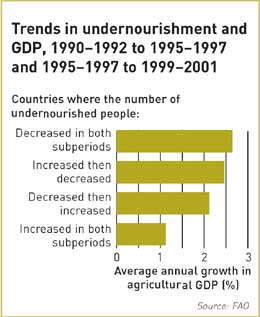
The Anti-Hunger Programme unveiled by FAO at the time of the WFS: five years later outlines just such a twin-track approach. It advocates measures to increase the productivity and improve the livelihoods of small-scale farmers and landless labourers. At the same time, it proposes immediate action to give hungry people access to the food they need.
The Anti-Hunger Programme paper sets out priorities and budgets for action in five areas:
The FAO paper also proposes how the estimated extra public investment of US$19 billion per year to enhance agricultural growth and productivity could be financed. Costs would be divided equally between the govern ments of countries where hunger is a problem and international donors. This would represent a doubling of conces sional funding for agriculture from developed countries and an average increase of about 20 percent in total expenditures for agriculture by developing countries.
Ultimately the success of anti-hunger programmes will depend on winning support
and commitment at both the national and international levels. To that end, FAO
has endorsed proposals to forge an international Alliance against Hunger that
would unite national gov ernments, the international community, civil society
organizations, the private sector and concerned individuals to mobilize the
political will, technical exper tise and financial resources needed to reduce
the number of hungry by at least half by 2015.